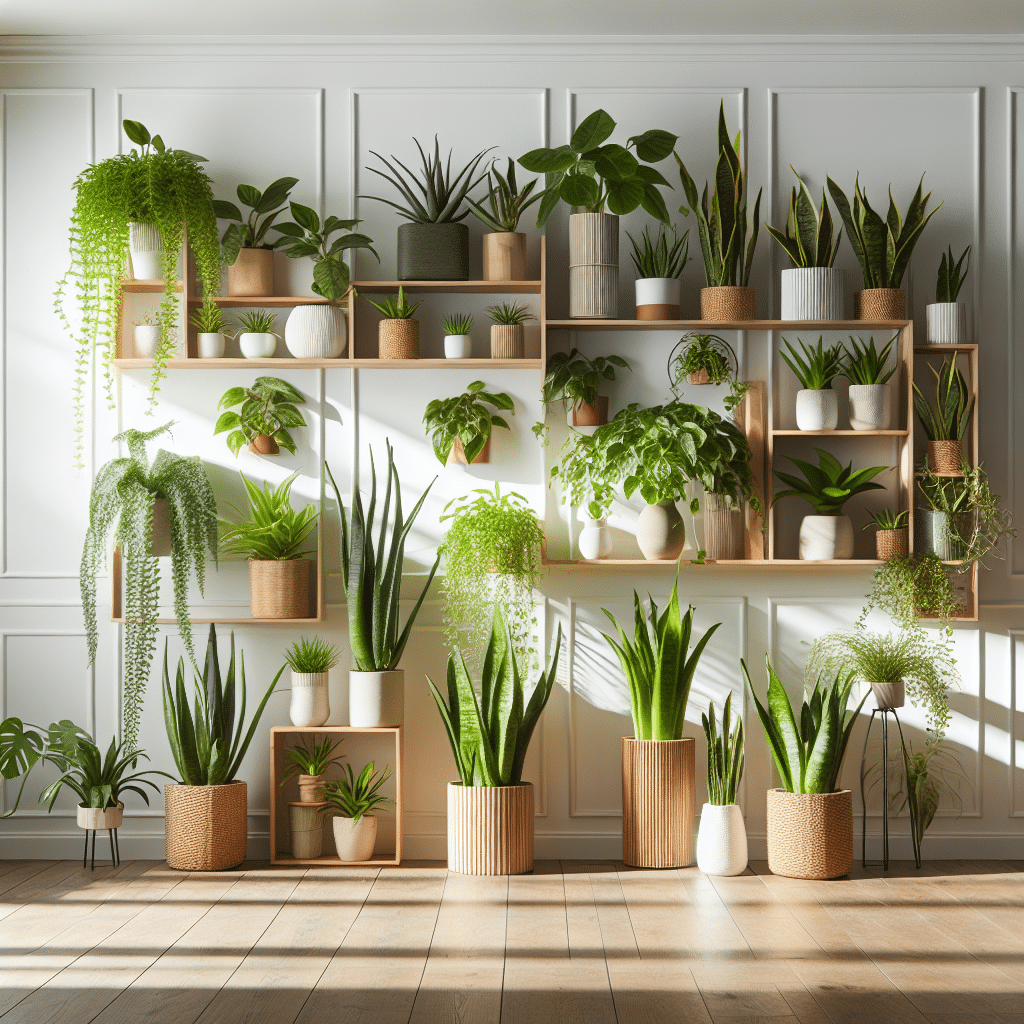The Benefits of Indoor Plants for Air Quality
Indoor plants not only beautify your space but also purify the air. Certain plants are particularly effective at removing harmful toxins such as formaldehyde, benzene, and carbon monoxide from the air, making them essential for our health. Below are some of the best indoor plants renowned for their air-purifying qualities.
1. Spider Plant (Chlorophytum comosum)
The Spider Plant is known for its ability to remove pollutants like formaldehyde and xylene. This hardy plant is great for beginners and thrives in indirect sunlight. It prefers well-draining soil and can tolerate occasional neglect, making it an ideal choice for busy lifestyles. Additionally, Spider Plants are excellent for filtering indoor air, helping to mitigate symptoms of allergies and respiratory issues.
2. Peace Lily (Spathiphyllum)
The Peace Lily, with its elegant white flowers, is another gem in the indoor plant world. It is particularly effective in absorbing toxic substances such as benzene, formaldehyde, and ammonia. It enjoys bright, indirect light and high humidity, making it suitable for bathrooms and kitchens. Regular watering and occasional misting will keep your Peace Lily healthy. However, be cautious, as the leaves are mildly toxic to pets.
3. Snake Plant (Sansevieria trifasciata)
Also known as Mother-in-Law’s Tongue, the Snake Plant is exceptional at converting CO2 into oxygen during the night. This plant thrives on neglect and can survive in low light and low humidity, making it one of the most resilient indoor plants available. It can absorb toxins like formaldehyde, benzene, and xylene, making it a great choice for bedrooms and offices.
4. Boston Fern (Nephrolepis exaltata)
The Boston Fern is a lush, feathery plant that excels at cleaning the air. It effectively absorbs formaldehyde and other toxins while adding humidity to the air, which helps in alleviating dry skin and respiratory issues. The Boston Fern thrives in a cool, humid environment with indirect light. Keeping the soil moist will encourage its vigorous growth, but be sure to avoid waterlogging.
5. Bamboo Palm (Chamaedorea seifrizii)
Bamboo Palm is not just visually appealing but also a champion in filtering out benzene, formaldehyde, and trichloroethylene. It prefers bright, indirect light and thrives in well-drained soil. Moreover, this palm helps in increasing humidity levels, which can be especially beneficial in dry indoor environments. Ensure to keep the plant well-watered, and you may enjoy its air-purifying benefits all year round.
6. Rubber Plant (Ficus elastica)
Renowned for its striking leaves, the Rubber Plant is not only aesthetically pleasing but also an effective air purifier. It can remove toxins such as formaldehyde and is known for its ability to adapt to varying light conditions. Typically, it prefers indirect sunlight and well-draining soil. Overwatering can lead to root rot, so be careful not to overdo it. With proper care, this plant can grow quite tall and serve as an attractive focal point in your home.
7. Dracaena (Dracaena spp.)
Dracaena is a versatile and widely popular houseplant that comes in various species. Most varieties are excellent at removing toxins like benzene, formaldehyde, and trichloroethylene. They adapt well to low light and require minimal feeding, making them an excellent choice for indoor areas. Dracaenas prefer to dry out between waterings, as too much moisture can be detrimental to their health.
8. Pothos (Epipremnum aureum)
Pothos, or Devil’s Ivy, is one of the easiest plants to take care of. It can thrive in various indoor conditions and is effective in removing indoor air pollutants like formaldehyde, xylene, and benzene. Pothos can grow in low light but prefers bright, indirect light for optimal growth. It also has an appealing trailing growth habit, making it an excellent choice for hanging baskets or shelves.
9. Areca Palm (Dypsis lutescens)
The Areca Palm is not only beautiful with its feathery fronds but also acts as a natural humidifier and air purifier. It effectively removes toxins such as formaldehyde, xylene, and toluene. This palm prefers bright, indirect light and needs regular watering to maintain soil moisture. It’s a great addition to living rooms and bedrooms, improving both air quality and aesthetics.
10. Aloe Vera (Aloe barbadensis miller)
Not only is Aloe Vera known for its healing properties, but it also serves as a natural air purifier. It can absorb formaldehyde and benzene, commonly found in household cleaning products. This succulent prefers bright sunlight, but it can tolerate indirect light. Water sparingly, allowing the soil to dry out between waterings, which helps prevent root rot.
Practical Tips for Growing Indoor Plants
-
Placement: Choose the right spot for your plants by considering the light requirements. Most plants don’t thrive in direct sunlight but do well in bright, indirect light.
-
Watering: Water your plants based on their specific needs. Overwatering is a common mistake that can lead to root rot.
-
Humidity: Maintain humidity levels suitable for your plants. A humidifier can help, especially in dryer months.
-
Fertilization: Feed your plants with a balanced fertilizer every few months to promote healthy growth.
-
Dusting Leaves: Keep the leaves clean by wiping them with a damp cloth. This process helps improve photosynthesis and boosts the plant’s air-purifying abilities.
-
Repotting: As plants grow, they may need to be repotted to provide enough space for root growth. This usually needs to be done every 1-2 years, depending on the plant’s growth rate.
-
Pest Control: Regularly check your plants for pests. If you encounter issues, consider organic methods of pest control to minimize chemical exposure.
Final Thoughts
Investing in indoor plants not only enhances the aesthetics of your space but also significantly improves your indoor air quality, promoting overall health and well-being. Choosing the right varieties, understanding their care needs, and strategically placing them in your home can help you create a healthier living environment. Start your indoor garden journey today and enjoy the many benefits these natural air purifiers bring!
